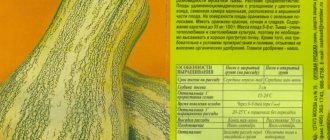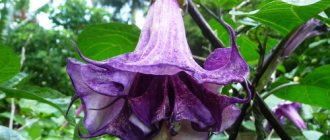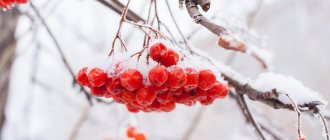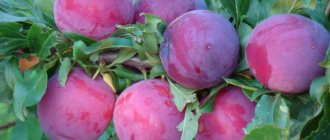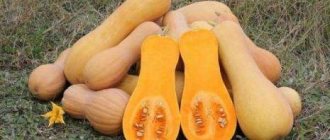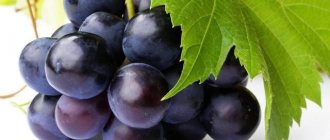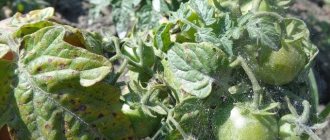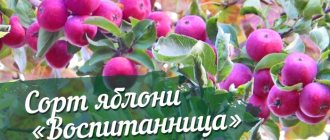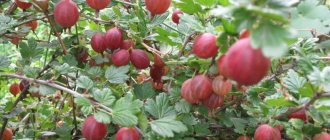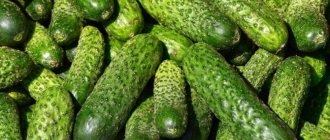Popular types and varieties of rowan
The rowan bush or tree belongs to the Rosaceae family. There are about a hundred of its species in the world. Rowan grows in North America, Europe and Asia.
Ruby rowan
Medium height plant. The length reaches from 3 to 4 m. The average weight of the fruit of such rowan is 1 – 1.5 g. The berries have a flattened shape and yellow flesh. They taste sweet and sour. The leaves are small in size, pointed at the ends, and have a light green color. The tree is resistant to low air temperatures, which makes it possible to plant it in regions with harsh climates.
Rowan Titan
A medium-sized tree obtained by crossing varieties of rowan, apple and pear. The culture has a branching crown of a brown hue. The fruit is oblong and has a dark cherry color. A light white tint is visible at the end of each berry. The pulp is bright yellow, not dense. The taste is very pleasant and delicate, with a slight sourness and a pear aftertaste. The leaves have a medium oblong shape, pointed at the edges. The color of the plates is dark green.
Rowan Vefed
The tree is of medium height. At maturity it reaches about 4-5 m in height. The crown has a spherical shape. The shoots and trunk are brown. The fruits of the tree weigh a maximum of 2 g. They are round in shape and purple in color. Ripe berries have a pronounced sweet and sour taste. The first fruiting is observed in the 5th year of the tree’s life.
Rowan Bead
The tree does not exceed a height of 3 m. The crown has a roundish shape and is small. The branches are gray-brown in color, abundantly covered with colorful leaves. Medium sized shoots. The leaves are rounded and pointed at the edges. All plates have a rich green color. The fruits of the tree are brownish-purple. The taste is tart-sweet with a slight sour aftertaste. The tree tolerates low temperatures well and does not require special care. Due to its high characteristics, Businka rowan is often used for planting in the northern regions of the country.
Rowan Vefed has the highest degree of productivity.
Mountain ash
The tree can reach six meters in height. It has a medium rounded crown. Rowan fruits are dark and large. Liqueur liqueur differs from other types in its berries, which have high taste qualities. They taste sweet, slightly tart with a complete lack of acid. Tree of average productivity. It also begins to bear fruit in the fifth year of life.
Scarlet rowan
It is a rather beautiful shrub or tree that has a spherical or pyramidal crown. The rowan tree reaches ten meters in height. The tree has a well-developed root system. The leaves are dark green, not paired. The plant is distinguished by abundant and large fruits, collected in handfuls. The berries are sweet and sour, slightly tart. The pulp has a bright yellow tint. In spring, the tree is covered with inflorescences that resemble shield-shaped cones.
An excellent place for growing such rowan will be fertile, chernozem or woody clay soil. For good development, the bush should be periodically watered and fertilized. The tree loves the sun very much, so it should not be planted in the shade. The plant is resistant to high frosts and various diseases.
During flowering, scarlet rowan exudes an unpleasant aroma.
Fairytale rowan
The tree of the variety has medium height. The crown type is oval, abundantly covered with foliage. The bark has a gray tint. The shoots are elongated and straight. Ripe fruits have a red-orange hue. Each berry weighs about 2 g. The taste of rowan is sweet and sour, the pulp is quite dense. The leaves are flat, bright green with a matte tint.
The berries begin to ripen in late autumn. The presented species also perfectly withstands low temperatures and sudden changes in weather conditions. Fairy rowan is unpretentious in care, which allows it to be grown in any soil and area.
Description of Liqueur Rowan
An adult tree reaches a height of 1.5-2.5 m, the crown is sparse, oval-shaped, the diameter does not exceed 1-1.5 m. The annual growth of young seedlings is 25-30 cm.
In summer the foliage is dark green, in autumn it acquires bright shades: yellowish-orange, red. The location on the branches is the same.
Flowering times depend on the growing region. The approximate time of appearance of inflorescences is the end of May or the beginning of June. After flowering, round shaped fruits are set. The color of the berries is purple-black, reminiscent of the color of chokeberry, diameter is 12-15 mm, weight is about 2 g.
Harvest ripening occurs in September
The fruits of the rowan liqueur are used for food. The fresh harvest can be stored for no more than a month. The berries can be dried or made into jam and liqueur. The taste of the fruit is sweet, with slight astringency, without bitterness.
Drought resistance, frost resistance
Rowan Licker is a frost-resistant crop that can withstand temperatures down to -40 °C, so it is grown in various regions of Russia. Late flowering protects the crop from return frosts.
The drought resistance of the crop is average. Young seedlings need regular moderate watering; adult specimens need to be moistened 3-4 times per season.
Does the variety need pollinators?
Most rowan varieties bear fruit without pollinators, but Likernaya is considered self-sterile, so it needs to be planted with other specimens that bloom at the same time. Experts recommend choosing Nevezhinskaya, Rubinovaya, Kubovaya, Daughter Kubovaya or Burka as a pollinator.
Advantages and disadvantages of the variety
Each variety has pros and cons. Considering the rowan liqueur, the following advantages can be highlighted:
- beautiful appearance, allowing the seedlings to be used for decorative purposes;
- high resistance to frost;
- late flowering, protecting against spring return frosts;
- pleasant berry taste.
Among the disadvantages of the variety, gardeners note poor resistance to diseases and pests.
Planting and caring for rowan Lickernaya
Rowan liqueur is in the most related relationship with such famous fruit trees as apple and pear. Therefore, planting and caring for trees are very similar in their agricultural technology.
Preparing the landing site
It is better to choose a sunny place for planting a fruit tree. Although the plants can tolerate partial shade, they will bear fruit worse in such conditions.
Advice! You should not plant rowan next to a pear tree, since they have a common set of pests that can move from one tree to another.
This variety of rowan does not have any special requirements for soil, although it is better to avoid excessively heavy soils with excessive moisture. Saline soils will also not be the best option for it. The best yields can be achieved when planting the tree in well-drained, loamy, fertile soil with a slightly acidic or neutral reaction.
Landing rules
Considering the good resistance of this rowan to cold, it can be planted in the ground in a permanent place in two terms. Either in early spring, before the buds open, or in the fall, after all the leaves fly off.
The roots of the tree are located quite close to the surface, so the planting hole must be prepared not so much deep as wide. That is, the depth of the planting hole can be 60 cm, with a diameter of 100 cm. Before planting a tree with an open root system, it is soaked in a bucket of water a day before the process itself.
Then the roots of the seedling are placed in the prepared hole, straightened and carefully covered with the removed soil mixture. For better tree development, you can add wood ash, sand and compost or humus to the soil mixture.
If several rowan trees are planted, then the distance between them should be at least 4-5 m.
It is customary to mulch the root zone with available organic material: rotted sawdust, mown hay, straw or tree bark. This will help retain moisture at the roots, protect against the most aggressive weeds and provide additional nutrition. In addition, due to the shallow location of the root system, loosening may not be a safe procedure for the tree's roots. And mulching will take over all its functions.
Watering and fertilizing
In the first few years after planting, young trees need regular but moderate watering. This especially needs to be done during the hot and dry summer period. Mature trees over 5 years old no longer need additional watering, except during periods of extreme drought.
Fertilizers are usually applied when planting mountain ash. In addition to a bucket of humus, it needs 500 g of superphosphate, 1000 g of wood ash or 250 g of potash fertilizer per tree. In the future, fertilizing is carried out once a year in the spring. You can use both organic and mineral fertilizers.
Trimming
For rowan liqueur, all types of pruning are performed in early spring. Moreover, this needs to be done as early as possible, because the buds of these plants wake up quite early, already in April.
In the first years after planting, formative pruning is especially important. It is necessary to shorten or cut off all branches that thicken the crown, as well as those growing at an acute angle to the trunk. This will avoid future trunk fractures and increase the illumination of the central part of the crown. Which in turn will lead to increased productivity.
At an older age, thinning and rejuvenating pruning is carried out. After these procedures, the trees need additional care: fertilizing, regular watering, and mulching.
Sanitary pruning should be carried out annually, trying to promptly remove dry, damaged, diseased and rubbing branches.
Rowan shoots grow and ripen quickly, so even after severe pruning there should be no problems with their ripening by winter.
Preparing for winter
Rowan liqueur can withstand frosts down to – 40 °C and therefore does not need special shelter for the winter. It is much more important to protect young plantings from damage by rodents and hares, as well as from possible sunburn in early spring. To do this, the trunk is whitened in the fall using a special garden composition and, in addition, it can be wrapped in burlap to protect it from small mammals.
Pollination
As mentioned above, rowan of this variety is practically a self-fertile tree. Therefore, for good harvests, she needs several trees of other varieties growing nearby. Rowan varieties such as Rubinovaya, Kubovaya, Daughter Kubovaya, Burka will play their role well.
Harvesting
The fruits begin to ripen approximately 4-5 years after planting. They are able to stay on branches for a long time. But birds love to feast on them. Therefore, sweet varieties of rowan, which includes liqueur, are recommended to be collected as quickly as possible, even before frost.
From one tree you can collect up to 20 kg of berries.
1 Description of varieties
Rowan, whose Latin name is Sorbus, belongs to the woody plants of the Rosaceae family. Its distribution area is extremely wide. It is found everywhere in Europe and grows in the Caucasus and Western Asia. The culture can be seen even in the Far North, and in mountainous areas, shrubby species reach the vegetation line. Rowan received its scientific name from the Celtic language. It characterizes the taste of the berries and is translated as “bitter” or “tart.”
In the Soviet era, the famous breeder I.V. Michurin successfully developed new varieties of this fruit tree. As a result of his activities, Likernaya and Garnetnaya rowan trees were obtained. They are distinguished by improved taste, large berry size and good frost resistance.
We recommend
1.1 Rowan pomegranate
An adult tree of this variety can reach four meters in height. Its lifespan and fruiting period is no more than 25 years. Pomegranate rowan has a wide spreading crown and a developed fibrous root system. Its shoots quickly take root; the seedlings tolerate extreme heat in the summer and a significant drop in temperature in the winter months.
Large dark green leaves are particularly decorative. They are arranged alternately, in an odd-pinnate manner. The group includes from 9 to 11 oblong leaves, about 9 cm long and no more than 6 cm wide.
Pomegranate rowan blooms with small white flowers that appear in early June. Each corymbose inflorescence contains up to 100 of them. After flowering, fruits form in their place. In young trees, the berries are concentrated at the base of the fruit twigs. In adult plants they form on ringlets, the lifespan of which is up to 5 years.
The harvest can be harvested at the end of August. Ripe pomegranate rowan berries are described as having a spherical shape with a clearly defined faceted structure. They are covered with a bluish coating and have a scarlet or burgundy color. Inside there is juicy yellow pulp. The fruit tastes sweet and sour with a slight tartness. With proper care, the variety gives high yield: up to 20 kg of berries weighing up to 1.6 g are harvested from one tree.
The fruits of this variety can be eaten raw. They are also used to prepare jams, jams, juices and compotes.
This variety is distinguished by early fruiting. The first harvest can be harvested already in the fourth year after planting the seedling. Picked berries are kept fresh for five months if kept in a cool room without access to moisture. In addition to various preparations for the winter, the fruits are dried and frozen.
Pomegranate rowan is one of the self-fertile ones, but experienced gardeners still advise planting the varieties Wefed, Dessertnaya Michurina or Sorbinka nearby. They are used for cross-pollination and improved yields.
1.2 Rowan Liquor
This variety, like the previous one, is the fruit of the works of I.V. Michurin. It was bred as a result of crossing chokeberry and rowan. The result was a tall tree, reaching five meters in height with good resistance to frost. Liqueur rowan is characterized by particularly intensive growth - during the growing season, growth reaches 30 cm. The odd-pinnate leaves have a dark green tint, which turns into red-yellow with the onset of the autumn months.
Depending on the climate, liqueur rowan blooms in late May or early summer. At this time, small pinkish flowers bloom, emitting a strong aroma. They are collected in large thyroid inflorescences.
The sweet-fruited liqueur variety begins to bear fruit at the age of four. This is a self-fertile variety, so it requires pollination. It is best to use mountain ash of the Burka or Nevezhinskaya variety for this purpose. The berries begin to ripen gradually in early autumn. Inky spherical fruits weighing up to 2 g have a sweet, tart taste without a hint of bitterness.
Jam made from this variety tastes very much like cherry. Liqueur rowan berries are also used to make delicious ruby wine.
Aftercare
It will not be possible to grow an ornamental tree without proper care. Rowan Licker requires timely watering, periodic pruning, and fertilization.
Young seedlings need regular but moderate watering. Waterlogging and drying out of the soil negatively affects the condition of mountain ash.
Adult specimens are watered only during periods of severe drought. If it doesn’t rain in summer, it’s enough to pour 20 liters of water under the rowan tree once a month.
If fertilizers were applied during planting, then the first fertilizing is carried out no earlier than 2-3 years later. Organic and mineral fertilizers are used. It is enough to apply fertilizer once a season; experts recommend doing this in the spring.
The buds of Lickernaya mountain ash swell in April, so pruning is planned at an early date. Formative pruning involves removing branches that thicken the crown and grow inward at an acute angle.
Pruning allows you to extend the life of the tree, so you cannot refuse to carry out the procedure
With age, sanitary and anti-aging pruning may be required. Trim broken and diseased shoots. The procedure is carried out in spring or autumn.
Young trees need preparation for winter. The tree trunk circles are mulched with available materials and covered with spruce branches. The issue of protection against rodents is relevant. Mice and hares love to eat rowan bark. To protect trees from rodents, the trunk is wrapped in burlap. To prevent sunburn in the fall, the bark is whitened with a special composition containing lime.
Rowan nevezhinskaya - the legend of our ancestors
depositphotos.com
What is this plant famous for? You will learn about it from our material.
What is Nevezhinsky rowan famous for?
The first cultivated varieties of mountain ash in our country were obtained by I.V. Michurin – Burka, Granatnaya, Lickernaya, Michurinskaya dessert and others. They were distinguished by a pleasant sweetish taste of the fruit without bitterness, large size and attractive appearance of the bunch. Until this time, wild rowan bushes were found everywhere, but their fruits were very bitter and astringent. But one day luck smiled on our inquisitive ancestors.
In the village of Nevezhino, located near Suzdal and 150 versts from Moscow, in the 19th century, a peasant accidentally found a rowan tree in the nearby forest with fruits of a sweetish taste and a complete absence of bitterness. This natural form of mountain ash was propagated, became widespread among local residents and was named Nevezhinskaya based on its place of growth. From this and nearby villages, peasants went to work in many other provinces, and with their stories, the fame of the Nevezhin mountain ash and its seedlings spread throughout the country.
icdn.lenta
This wonderful plant was not ignored by Pyotr Arsenievich Smirnov, a native of serfs who opened his own vodka production in Moscow. In 1899, he sent samples of his products to Paris to the World Exhibition. The vodka liqueur “Nezhinskaya Rowan”, bottled in elegant elongated bottles, received a big gold medal and real delight among Parisians.
French newspapers wrote about this product as a Russian miracle, and interest in it grew both among ordinary French people and competing winemakers, who decided to find out the secret of its production by any means possible.
But Smirnov turned out to be more cunning than them. When he first found and tried the famous sweet Nevezhin rowan, he decided to produce his own drink based on it.
He bought fruits from peasants from that same village of Nevezhino and nearby places, froze them and sent them to his factory. The absence of bitterness and the sweetness of the fruits of the Nevezhin rowan immediately made his tincture famous. And in order to confuse competitors, Smirnov named the drink “Nizhyn Rowan” - after its delicate taste and after the name of the city of Nizhyn, located in completely different parts, 80 miles from Chernigov. According to legend, according to Smirnov, “so that others would not covet”, they even had to change the labels on the finished bottles - from “Nevezhinskaya Rowan” to “Nezhinskaya”.
depositphotos.com
And competitors who were looking for that very valuable raw material and collecting rowan in the vicinity of Nezhin received a completely different drink - the bitterness of the local fruits made itself felt and did not disappear even when diluted with syrup. So the secret of Smirnov’s “Nizhyn rowan” lasted for a long time, for three decades this tincture had no equal...
And then the first cultivated varieties of sweet-fruited rowan appeared, they learned to produce concentrates and aromatic additives from the fruits, they modernized production, and the former glory of Smirnov’s famous drink began to disappear. Cognac liqueurs with rowan appeared, and vodka liqueurs with it, and re-releases of that same drink, but they did not have the legendary taste and former glory.
Rowan propagation
To grow rowan, it is customary to use two methods: vegetative and seed. Species rowan usually reproduces by seeds. Preparing seeds for sowing occurs in the fall.
- Ripe berries are selected, the seeds are removed from them, the pulp is thoroughly washed and dried.
Rowan seeds need to be cleared of pulp and dried.
Valuable rowan varieties are usually propagated vegetatively. For this purpose, grafting, shoots or layering, green or lignified cuttings are used. A traditional rootstock for grafting can be a rowan tree. Budding (grafting) is carried out in April, when sap flow begins. If the spring deadlines are missed, then budding can be carried out in late July - early August. The bandage is removed from the vaccination site after 20–25 days.
Planting stages
Since rowan is a frost-resistant fruit tree, it can be planted in early spring or closer to autumn, without fear that it will encounter frost.
The optimal soil option is loam. The description says: it is best if the soil has a slightly acidic reaction so that the plants can develop normally.
It is unacceptable for the Liquor Representative to suffer from stagnant water or soil salinity. Both factors have a negative impact on the plant and can lead to a decrease in the viability of the tree. Rowan roots are located too close to the top layer of soil, so the tree trunk circles must be processed very carefully.
Rowan loves sunny places, so it is better to place it in the sun. A slight darkening will not frighten the Licker mountain ash; you can plant it there too. 4–5 years after planting, usually in mid-September the first fruits ripen. The yield is very high, so you can get a sufficient amount of juicy and ripe berries. The tree reaches a height of 4–5 m, having a sparse crown.
The fruits remain fresh for a month; it is necessary to pollinate the tree. The best pollinators will be Burka and varieties of Nevezhinsky mountain ash.
When planting rowan, you need to pay attention to the following subtleties:
- the planting hole should be up to 100 cm in diameter and 60 cm deep;
- Fertilizers must be applied (20–30 kg);
- you need to introduce a little superphosphate (500 g) and 250 g of potassium in fertilizers;
- you will need 1 kg of ash;
- if the soil is acidic, you need to add 500 g of lime;
- trees should be planted at a distance of 3–5 m from each other;
- To get a bountiful harvest, it is best to plant trees of different varieties.
Diseases
This tree is resilient, but there are weak points. First of all, it is prone to the formation of rot. This is due to the large amount of water. If you pour liquid, the Liqueur variety will certainly suffer and simply rot.
Brown spot
Rowan moth also has a negative effect on the plant. This insect can destroy young shoots and harm the tree. To avoid problems, it is necessary to spray with Actellik. It is advisable to do this 7–10 days before the flowers appear.
The plant can suffer from bacterial necrosis, brown spot, monilial blight, septoria and viral ring spot.
Ruby
The Michurin variety was also lost, but was found, propagated and transferred to T.K. Poplavskaya for variety testing. Like all old Michurin forms, this type of rowan has a slight astringency in taste .
Its characteristics:
- A low tree, 3 meters in height, with a drooping crown. The skeletal branches are located almost at right angles, the shoots are straight, with light brown integuments.
- The leaves are light green, with a finely serrated edge and a pubescent petiole.
- The scutellum is not wide, the flowers are small, pinkish-white.
- The fruits are rounded and flattened, weighing 1.3 g. The skin is ruby-colored, the flesh is yellow. The taste is sweet and sour, slightly tart. The purpose of the fruit is for processing into juices, jellies, wines, liqueurs, jelly. Suitable for drying.
The plant is resistant to low temperatures.
Rowan of the Rubinovaya variety is good for processing into juices, jellies, wines, liqueurs, jelly
| Chemical composition of fruits | |
| Sugar | 12,4% |
| Organic acids | 1,3% |
| Vitamin C | 21 mg/100 g |
| Anthocyanins | 948 mg/100 g |
Rowan fruits of the Rubinovaya variety can replace raisins after drying. To do this, you need to place them in a gauze bag and hang them by the radiator for a while.
4 Landing
The correctness of this operation largely determines how successfully the tree will develop and bear fruit well. Planting is done step by step as follows:
- 1. Dig a hole, the dimensions of the sides are 1 m, and the depth of the hole should reach 50 cm.
- 2. When planting in the fall, a nutrient mixture of removed soil and fertilizing is placed on the bottom of the hole. If the soil is too acidic, add an additional 0.5 kg of crushed chalk or lime.
- 3. Lay a small layer of soil to prevent burning of the root system.
- 4. Dig a stake into the planting hole, which will serve as a support for the developing plant.
- 5. The root system of the crop is placed on a mound of soil and covered with soil removed from the hole.
- 6. When planting, the seedling is installed so that its root collar is 3 cm above ground level.
- 7. Then they press down the earth around the trunk and tie the tree to the support.
- 8. The seedling is watered abundantly, and the ground around the trunk is mulched to reduce moisture evaporation.
Crops planting scheme
If several specimens are planted, then a distance of at least 4 m is maintained between them. To increase productivity, other varieties of rowan are placed nearby.
Growing rowan
To grow rowan in the garden, you need to perform the usual operations when caring for fruit trees.
Watering
It is necessary to water rowan immediately after planting in a permanent place, as well as at the beginning of the growing season or during a period of prolonged absence of precipitation. It is advisable to provide additional moisture 10–15 days before harvesting, as well as 10–15 days after harvesting. Each tree requires up to 3 buckets of water.
You need to water in the grooves around the tree trunk, and not directly under the root.
Loosening
Loosening the soil around the mountain ash is carried out several times during the spring-summer season. The first time to loosen the soil is in early spring. In summer, loosening is carried out 2–3 times. It is best to produce it on the second day after rain or watering. Afterwards, the soil around the trunk is mulched with organic matter.
Fertilizer application
In the 3rd year of life, the rowan tree needs the first feeding, which is carried out in early spring. You need 5–7 kg of humus or compost and 50 g of ammonium nitrate (per tree). The best time for the next feeding is the beginning of June. Rowan is watered with mullein solution (in a ratio of 1:5), you can use bird droppings (in a ratio of 1:10). 10 liters of solution per tree will be enough. Instead of organic matter, you can use Agrolife fertilizer. In August-early September the last feeding is carried out. This will require 2 tbsp. wood ash and 0.5 tbsp. superphosphate.
Rowan pruning
In the 2nd year of life, the tree needs to undergo the first pruning to avoid thickening of the crown and create a strong skeleton. When forming a pyramidal crown, it is important to consider that shoots growing at right angles to the main trunk are initially removed. Next are branches growing at an acute angle, since they lack strength. Therefore, the gardener should try to preserve the skeletal branches of those that grow at an obtuse angle.
You shouldn’t get too carried away with pruning; it can do more harm than good. If the bark of the trunk and main skeletal branches is pruned too often, it can be so exposed that there is a risk of sunburn.
Tree pruning is divided into three types:
- sanitary pruning (as necessary, when you need to remove broken, dried or diseased branches);
- rejuvenating pruning is required to restore the strength of the tree. The need for it appears if the plant growth does not exceed 10–12 cm per year, but the yield remains high. It is carried out in two steps: in the first year, 50% of the branches are pruned, and the same amount will remain for the next year. Strong anti-aging pruning is needed when there is no growth or it is no more than 5 cm per year, and the yield is also reduced. It consists of rejuvenating skeletal (semi-skeletal) branches into wood every 6–7 years. At the same time, mineral feeding of the tree is necessary;
- growth restriction pruning is needed to coordinate the height of the tree. It is carried out in the 8th–10th year of the rowan tree’s life, and is especially relevant for varieties of the so-called “folk” selection. As a result of pruning, the central sprout is removed, replacing it with any branch from the upper tier.
Rowan needs annual pruning
Pruning rowan in spring
It is best to prune rowan while the buds have not yet swelled, that is, in early spring. Each wound exceeding 3 cm in diameter must be treated with garden varnish. Covering the wound will protect the rowan from infection with diseases, prevent drying out and accelerate the formation of callus.
Pruning a mature tree in early spring involves thinning the middle of the tree's crown, as well as directing the central conductor to a side branch. In addition, be sure to remove damaged and dry branches.
A young tree should not be heavily pruned, because this leads to the development of shoots and, accordingly, to a decrease in yield.
Video: pruning rowan
Plant characteristics
Liqueur rowan appeared thanks to the efforts of I.V. Michurin, who crossed rowan with chokeberry. The result of his labor was a slender tree producing inky black fruits. It looks great both in the garden and in alley plantings.
The liqueur “beauty” grows up to 5 m, giving growth every year. Its leaves are dark green, odd-pinnate. Rowan also has beautiful inflorescences resembling corymbs and pale pink petals.
The plant is cold-resistant and tolerates frosts well. Rowan is quite unpretentious, so caring for it does not take much effort and time.
Features of berries:
- size –12–15 mm;
- the fruits are slightly tart, with a sweet taste;
- the pulp is very juicy;
- no bitterness;
- They make excellent jam, reminiscent of cherry;
- The berries can be used to make very tasty, bitter-free wine.
Liqueur rowan makes a healthy and tasty compote
It is also worth noting that you can prepare a compote from the fruits of Liqueur Rowan, which will have a different taste and a large amount of vitamins. Ripe fruits contain malic acid, tannins and pectin, as well as copper, boron, manganese and vitamin P.
Other decorative varieties
There are other varieties of Michurin that gardeners often choose for themselves. These are Titan, Businka, Rubinovaya, Scarlet large, as well as white, yellow and orange varieties.
- Titanium. Appeared as a result of the work of Michurin. It is a combination of rowan, pear and red-leaved apple. Externally, this is a tree up to 5 m, with straight shoots and brown bark. It has dark green leaves and snow-white petals. Slightly ribbed, with red skin, each fruit has yellow, slightly sour flesh. It can be used for any purpose, and can also be grown even in dry places, since Titan tolerates lack of moisture and cold well.
- Bead. The author of this variety is T. Poplavskaya, who tried to restore the lost species of mountain ash from Michurin. Businka is one of the first varieties that does not have astringency, although the plant itself is only 3 m in height. Its leaves are light green in color and its shape is jagged. Large inflorescences are usually white. The fruits are round in shape, have a cranberry flavor and creamy flesh. They ripen early and are not affected by frost, drought and disease.
- Ruby. This variety is also the lost work of Michurin, which T. Poplavskaya tried to revive. Ruby rowan has a slight tartness and has the type of berries that are well used for liqueurs, juices, jellies, jelly, and wines. The tree is medium in size, has straight branches, and green leaves with pubescent petioles. Pinkish-white flowers give way to round, slightly flattened fruits. Yellow pulp and ruby-colored skin are the main features of the variety.
- Scarlet is large. This variety also belongs to Michurin. A spectacular plant, it has large fruits weighing up to 2.5 g. Their juicy appearance and pleasantly sour taste allow the fruits to be used for table purposes. The tree itself is 5 m high, has a dense crown, as well as slightly pubescent straight shoots. The leaves are dark green with beautiful flowers. A special feature of the variety is resistance to disease, as well as the ability to tolerate frosts - 50 ° C.
- White, yellow, orange varieties. These types of rowan are not only suitable for consumption, but also decorate the garden well. Yellow rowan is ideal for jam and also serves as a filling for pies. Orange varieties are Ogonyok and Daughter Kubova. Ogonyok is interesting because it is a heat-resistant type of rowan and can withstand even the most severe drought. Kubova's Daughter is characterized by a juicy taste, without the slightest bitterness. As for the white variety of rowan, it is not very suitable for food, since it has a bitter taste; this type of plant can create a pleasant color harmony in the garden.
Not only people love rowan very much
Diseases and pests
Among the pests, the berries are damaged by the rowan moth, which can switch to the apple tree in years when the rowan harvest is poor. At the beginning of the twentieth century, for this reason, rowan plantings were destroyed in North America, but in our country the damage was not so destructive, and the fight against rowan was never carried out, but on the contrary, its best selected forms began to decorate gardens. Rowan leaves are most often affected by aphids, mites, scale insects, sawfly larvae, and butterfly caterpillars. Among the diseases you can find on it is rust, the main host of which is juniper. Therefore, for prevention purposes, these trees should not be planted close to each other.
The most common fruit disease is fruit rot (moniliosis). In addition, rowan can suffer from powdery mildew, brownish spot, fire blight, wilt and some viral diseases. Pest and disease control measures are standard. In autumn, the harvest can be significantly thinned by birds, especially field thrushes and starlings.
Rowan berries are collected at the end of August or beginning of September, for jam earlier (while the seeds are still soft). With later harvesting, crop losses from birds and fruit rot increase sharply.
The resulting rowan berries can be used for a variety of preparations. The simplest preparation is soaked rowan. It is added to vegetable and rice side dishes for meat dishes, vinaigrettes, and sauerkraut salads.
Pastille is prepared from rowan berries, and the taste of the product obtained from fresh or frozen berries varies; jelly, syrup, homemade wines, tinctures and liqueurs are made, and canned along with tomatoes.
Test and photo: Natalia Alexandrova
Gardening matters No. 2-3 (88) 2016
Pests
The most dangerous and most often appearing insect on the plant is the rowan moth. It harms leaves and shoots. To protect against this pest, trees are regularly treated with Actellik. The first spraying is carried out with the onset of spring, after half a month the product is used again.
Pomegranate rowan is often affected by rowan aphids, which cause deformation of the leaves. To destroy it, the tree is sprayed with a solution of karbofos at a concentration of 0.2%. The procedure is carried out in the summer, before the ovaries appear. To prevent infection, in early spring, before the kidneys awaken, treat with a 2% solution of nitrophen.
To eliminate the rowan gall mite, which damages the structure of the foliage, the tree is sprayed with a 1% colloidal sulfur preparation before the flowers appear. In the fall, they dig up the soil in the tree trunks, collect and destroy rotten berries.
Rowan moth caterpillars eat the fruits. To destroy them, half a month after flowering is completed, the tree is sprayed with chlorophos at a concentration of 0.2%.
Planting rowan
Many varieties of mountain ash tolerate transplantation well and take root quickly in a new location. To obtain this result, you need to follow a few simple rules.
- September is ideal for planting and transplanting rowan seedlings.
- A tree requires a hole measuring at least 60x60 cm.
- To fill the hole, use a mixture of rotted manure with peat compost and topsoil. You can add 100–200 g of ash and superphosphate.
- Before planting, it is better to dip the roots into a clay mixture, then place them on a mound made in the middle of the hole and straighten them. The root collar of the plant should be located at ground level.
- The plant must be watered thoroughly (2-3 buckets per hole). It is necessary to water each layer of soil, then no voids will form under the roots of the seedling.
- The planted tree must be tied to a stake, and ideally to three tied sticks inclined towards the tree. This will create a protective frame for the seedling.
It is a mistake to trample the soil with your feet after planting. This leads to severe soil compaction and impairs the functioning of microorganisms.
Rowan is a tall tree, so it is worth ensuring that it does not shade other plantings. To obtain a higher yield of berries, it is necessary to plant several varieties of rowan on the site. The trees are located 5–6 m from each other.
Transplanting rowan to a new place
You can replant rowan according to its planting scheme. The only thing that needs to be taken into account is deep digging of the root system. If you have the skill of grafting plants, it is quite possible to dig up a wild mountain ash in the forest and transfer it to the garden. After complete rooting (usually next year), several cuttings of different varieties should be grafted onto the wildflower.
Features of reproduction
Rowan can be propagated in various ways. Liqueur is a developed variety, so the seed propagation method is undesirable, since the seedling may not inherit all the qualities of the mother tree.
Young specimens, the branches of which are located close to the ground, can be propagated by layering. To do this, the shoots are tilted towards the ground, fixed with a metal pin and covered with earth. When roots appear, the shoot is separated from the mother bush.
Green cutting method is available. During flowering, cuttings 15-20 cm long are prepared and buried in nutrient soil. The rooting rate of green cuttings is low - from 15 to 40%, so several shoots are cut for propagation.
One of the most effective methods of reproduction is vaccination.
Common rowan is planted as a rootstock, then shoots of the required variety are grafted onto it.
Reproduction
Like all varieties of rowan, this hybrid propagates in several ways:
- seeds;
- cuttings;
- layering.
The seed method is not very successful, as is the method of growing by layering. Gardeners mainly use the cutting method.
Harvesting cuttings
Shoots are harvested in early autumn. Fruit-bearing biennial branches with lignified bark are cut from trees. Each cutting should have two side branches with buds. The bottom cut is made with a sharp knife at an angle of 45°. With this cut, the shoots will release roots faster.
The prepared material is marked and sent for storage in a dark and cool place. About a month before planting in open ground, the branches are immersed in water. To speed up the process of root formation, root formation stimulants “Epin” and “Kornevin” are added to the water. Also add 1 tablet of activated carbon to prevent the formation of mold on the cuttings.
Planting cuttings in the garden
After about a month, roots will appear in the cut areas. This is a sign that it is time to plant them in open ground.
Planting cuttings is carried out according to the same rules as planting seedlings. The main care for cuttings consists of regular watering, weeding, fertilizing and pruning in the same way as seedlings.
This variety is frost-resistant, but at a young age the plants need shelter. Until the onset of cold weather, they are covered with pine needles, spruce branches, roofing material or fallen leaves.
Useful properties of rowan
All of the above varieties of mountain ash combine all the beneficial properties of this plant. Rowan fruits have a high content of vitamin P and carotene (provitamin A). Also contains vitamins C, K, B2, B9, and microelements. Rowan is valuable for its content of pectins, sugars, essential oils and organic acids.
In Bulgaria, rowan juice is boiled with sugar (for 1 kg of berries - 600 g of sugar), this remedy is used for rheumatism, and kidney stones and vitamin deficiencies are treated this way.
Scarlet rowan berries are a hemostatic agent. A decoction of flowers is good for hot weather. Honey is mixed with fresh leaves to treat scurvy. A decoction of the bark is used to treat inflammation and gargle for tonsillitis and other throat diseases.
Rowan juice is used to increase appetite. There is a sign that fresh rowan branches thrown into water disinfect it.
Doctors recommend that people with high blood pressure use berries in their daily diet. Or dry flowers and berries to brew as tea.
Rowan Daughter Kubova
A tree of universal purpose, medium-sized, with a paniculate, sparse crown. The description of rowan is as follows: the shoots are powerful, gray-green, rowan leaves are dark green in color, imparipinnate. It begins to bear fruit in the 5th year. Rowan berries Daughter Kubova are bright orange in color, weighing up to 2 g, with bright lemon pulp, tender and sweet, containing carotene and vitamin C. They ripen in mid-August, can be stored in the fruit storage for up to 1 month. The best soils will be loose and not swampy.
Fruit
The berries ripen in the first ten days of September. The fruits are spherical, inky in color, 13-15 mm in diameter, average weight - 1-2 g. They taste sweet and tart. The pulp is juicy without bitterness. The taste of jam and preserves made from rowan fruits is reminiscent of the taste of cherry jam. Tasty and aromatic wine is made from the berries.
The pulp contains many useful substances - vitamin PP, manganese, boron, copper, tannins, pectins and malic acid. Compote made from black fruits is a healthy drink for both adults and children.
Rowan Liquor produces large and not bitter fruits
Rowan Fairytale
Rowan Fairytale is a tree of medium height, the crown is oval and medium dense. The bark on the trunk is gray in color and smooth in texture, the shoots are straight, elongated, pubescent, dotted with lenticels. The maximum weight of orange-red fruits with loose, fine-grained, aromatic pulp is 2 g. The taste of the berries is sweet-sour and astringent.
The average yield of Fairytale mountain ash is 126.9 c/ha. The leaves of the plant are medium-sized, lanceolate, bright green and matte, with a flat leaf blade, a serrated edge and a long petiole. Rowan Fairytale - late autumn ripening, self-fertile, frost-resistant, withstands heat and drought quite well, has average resistance to diseases and various pests.
Important! Rowan Fairytale helps with atherosclerosis, has a diuretic and choleretic effect, and lowers cholesterol levels in the blood.
Rowan Ruby
A medium-sized plant, reaches a height of 3 m, with a thick drooping crown, branches extending from the trunk at an angle, and straight, rounded brown shoots. Rowan Ruby - medium ripening, universal use. Rowan ripens in early autumn and can be used universally.
The average weight of one-dimensional, flattened, ruby-colored fruits that ripen in September is 1.3 g. The yellow, dense pulp also has high taste - it is juicy, sweet and sour, very piquant. Rubican rowan contains sugar, acid, vitamin C. The leaves are medium-sized, short-pointed, light turquoise in color, pink flowers with a faint aroma.
Varieties of rowan.
Rowan "Ordinary" is the most popular variety of rowan, which has a large number of decorative subspecies that differ in color: from orange to deep red.
"Scarlet large."
This subspecies of rowan “Ordinary” is the most valuable variety of this species. The ripening period is medium-late. Breeders crossed several pear varieties to produce “Scarlet Large”. The plant is medium-sized, reaches a height of 6 meters; its crown is in the shape of a pyramid, medium in density; The fruits of this rowan are juicy, weigh more than 4 grams, look like cherry berries and have virtually no bitterness. The berries are cylindrical, slightly flattened, have a regular shape, as well as slight ribbing of scarlet-red color. The taste of the fruit is sweet and sour, with a spicy rowan aftertaste. “Scarlet large” is highly frost-resistant and can tolerate frosty periods down to -50 degrees. The variety has precociousness and versatility. The average yield of adult rowan is 150 kg or more.
"Bead".
A low-growing variety, a mature tree grows up to 3 meters. The rounded crown of the tree has medium density; Rowan fruits are round in shape, colored in red-ruby color, the taste is reminiscent of cranberry taste. The internal contents of the berries are juicy, creamy, medium dense, having a sweet and sour taste, not bitter or astringent. Fruiting of the variety begins 4-5 years after planting. The plant is heat-loving, highly frost-resistant, and has immunity to disease. The yield is stable, the fruits are well transported.
"Grenade".
The variety was obtained by crossing the “Ordinary” variety of rowan with the “Large-fruited” hawthorn. An adult tree grows up to 3-4 meters, the berries are identical in size to the size of cherry fruits. The taste of the berries is sweet and sour, slightly tart, and almost not bitter. The variety is highly frost-resistant, the yield indicator is decent, fruiting begins from 3 years after planting.
"Gorgeous".
The variety was obtained by crossing the “Ordinary” rowan with a pear. The crown of the plant is wide, pyramid-shaped, a mature tree grows up to 6 meters or more. Rowan is famous for its decent yield every year. The berries are large in size, have a slight tartness, weigh up to 2 grams, are painted in a bright orange-red color, and have an unusual elongated shape.
"Hope".
The plant is low-growing, its fruits are large, weigh 1.8-2 grams, and contain a large number of elements most valuable to humans. The variety has early fruiting and high yield.
"Ruby"
The tree is a dwarf, grows up to 2-2.3 meters, its crown is spreading, the fruits are large, weigh 1.8 grams, are ruby in color, their taste is sweet and sour.
"Titanium".
The variety was obtained in this way: scientists crossed the “Ordinary” rowan, pear and “Red-leaved” apple tree. The tree is medium-sized, its crown is wide, round in shape, the berries are large, weigh 2 grams, are painted in a dark scarlet color, and are covered with a bluish-tinged coating on top. The variety is frost-resistant and has a high yield every year.
Landing rules
Planting seedlings in open ground is allowed both in spring and autumn. Moreover, it is recommended to plant in the autumn. This way, by the flowering season, the crop will be able to finally take root and gain strength.
Before planting mountain ash, Kena needs to choose a site suitable for its cultivation. It is not recommended to place white rowan in wetlands. Excess moisture in the soil will lead to rotting of the roots and death of the plant.
It is also necessary to provide the tree with sufficient lighting. Since it is quite low, it is better to place it away from spreading tall plants. Lack of light can lead to the suspension of fruiting and flowering of the crop. It is recommended to plant Kene rowan in the southern or western part of the garden plot.
The ideal location is at the top of the slopes as there is plenty of sunshine, not too humid and quite warm. And in winter, large snowdrifts gather on the slopes, which shelter the plants from the cold and ensure their successful wintering.
Once the site has been selected, you need to prepare the planting holes. Their dimensions are approximately 50 centimeters in depth, width and length. The distance between adjacent holes must be at least 4 meters. It is recommended to plant white rowan next to other varieties of this tree. This improves the quality of pollination of the plant, which means the yield increases.
When using drainage, the depth should be increased by 20-30 centimeters. Turf soil, humus and sand are added to the planting hole in a ratio of 3:2:2
When filling the hole, it is important to ensure that the root collar is not buried in the ground.
Features of care
Caring for Kene rowan is standard. It includes regular watering, pruning and fertilizing of plants. Although Kene rowan does not like waterlogged soils, it still requires watering in dry times. It is carried out as the soil dries, usually 1-2 times a week.
If the rainy season arrives and the soil is sufficiently moist, there is no need to water the plant. The soil around the trees must be regularly loosened and then mulched: this will help control weeds. Sawdust, peat, humus and compost are used as mulching materials.
It is recommended to apply the first fertilizers in the third year after planting. In April, a mixture of nitrogen, phosphorus and potassium fertilizers is applied. To prepare it, take 20, 25 and 15 grams of substances, respectively, per square meter of soil. In summer, the same composition is added, but in smaller proportions: 10, 15 and 10 grams, respectively.
And in the autumn, only phosphorus and potassium fertilizers are used, 10 grams of each per 1 m². Nitrogen fertilizers are not used, as they act as a plant growth stimulator.
All fertilizers are dug up with a top layer of soil about 5 centimeters thick. Then the trees are watered.
In spring, rowan begins to grow quite actively
Therefore, it is important to trim the crown on time. During pruning, the longest branches are shortened, the crown is slightly thinned out
If the plant growth is insufficient, deep pruning of two- and three-year-old branches is carried out to stimulate the growth of new shoots.
Since Kene rowan is not highly frost-resistant, its roots should be mulched before the onset of winter. First of all, this is necessary for young trees. Adult plants can suffer from cold winds in winter. Freezing of white rowan buds means the absence of flowers and fruits on the plant this year.
Knowing and following the rules for planting and caring for Kene mountain ash, you can easily grow it on your site.
